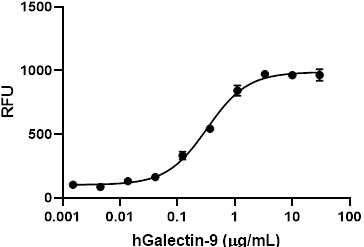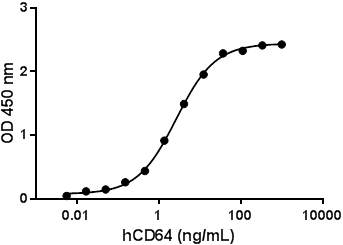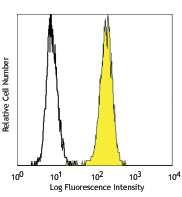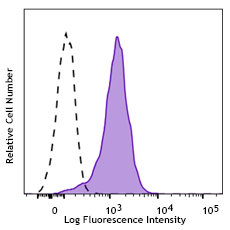- Regulatory Status
- RUO
- Other Names
- V-Set Immunoregulatory Receptor (VSIR), V-Domain Ig Suppressor of T Cell Activation (VISTA), Stress-Induced Secreted Protein-1 (SISP1), PDCD1 Homolog, Platelet Receptor GI24 (GI24), Death Domain1alpha, DD1 alpha
- Ave. Rating
- Submit a Review
- Product Citations
- publications

-

Human recombinant VISTA inhibits the anti CD3-induced proliferation of activated human T cells. -

Stability testing for human VISTA. Human VISTA was aliquoted in PBS at 0.2 mg/ml and one aliquot was kept at 4°C (control) and another was freeze-thawed four times (4 x freeze-thaws). After this procedure, the samples were tested by inhibition of anti CD3-induced proliferation of human activated T cells.
VISTA, V-domain Ig suppressor of T cell activation, suppresses T cell activation, was initially identified by affymetrix analysis of activated versus resting mouse CD25+ CD4+ natural Treg cells. Human Vista is a type I transmembrane protein with a single extracellular IgV domain, it is 311 amino acids (aa) long, contains a 32-aa signal peptide, a 130-aa extracellular IgV domain, 33-aa stalk region, 20-aa transmembrane domain, and 96-aa cytoplasmic tail. VISTA shares significant sequence homology with the B7 family ligands PD-L1 and PD-L2. VISTA is predominantly expressed in hematopoietic tissues, highly expressed in human placenta, which may be indicative of a functional role for VISTA in allofetal tolerance. Flow cytometry shows that human VISTA is expressed in subsets of CD11bhi blood monocytes, dendritic cells, about 20% of CD4 and CD8 T cells with low density, and CD66b+ neutrophils at an intermediate intensity. VISTA serves both as a ligand (for antigen presenting cells) and as a receptor (for T cells). B7-H5 expressing on APCs or soluble B7-H5-Ig fusion proteins inhibit T cell proliferation and cytokine production in vitro; also, inhibits the expression of the T cell activation markers CD44 and CD69. In murine tumor models, anti-VISTA monoclonal antibodies (mAbs) prime to an increased number and elevated function of intratumoral T cells and in that way boost antitumor immunity. VISTA is negative checkpoint regulator and a promising target for cancer immunotherapy.
Product DetailsProduct Details
- Source
- Human B7-H5 amino acids (Phe33-Ala194) (Accession # Q9H7M9) was expressed in CHO cells. The carboxy terminus contains SRIEGR-Fc-6His tag.
- Molecular Mass
- The 407 amino acid recombinant protein has a predicted molecular mass of approximately 45.8 kD. The DTT-reduced and non-reduced protein migrate at approximately 60 – 70 kD and 120 kD respectively by SDS-PAGE. The predicted N-terminal amino acid is Phe.
- Purity
- > 95% by SDS-PAGE gel as determined by Coomassie stained SDS-PAGE.
- Formulation
- 0.22 µm filtered protein solution is in PBS pH 7.2.
- Endotoxin Level
- Less than 0.1 EU per µg cytokine as determined by the LAL method.
- Concentration
- 10 and 25 µg sizes are bottled at 200 µg/mL. 100 µg size and larger sizes are lot-specific and bottled at the concentration indicated on the vial. To obtain lot-specific concentration and expiration, please enter the lot number in our Certificate of Analysis online tool.
- Storage & Handling
- Unopened vial can be stored between 2°C and 8°C for up to 2 weeks, at -20°C for up to six months, or at -70°C or colder until the expiration date. For maximum results, quick spin vial prior to opening. The protein can be aliquoted and stored at -20°C or colder. Stock solutions can also be prepared at 50 - 100 µg/mL in appropriate sterile buffer, carrier protein such as 0.2 - 1% BSA or HSA can be added when preparing the stock solution. Aliquots can be stored between 2°C and 8°C for up to one week and stored at -20°C or colder for up to 3 months. Avoid repeated freeze/thaw cycles.
- Activity
- Human recombinant VISTA inhibits the anti CD3 (Cat. No. 317303)-induced proliferation of activated human T cells; the inhibitory effect was measured using Deep Blue Cell Viability™ Kit (Cat. No. 424701). The ED50 = 0.5 – 3 µg/ml.
- Application
-
Bioassay
- Application Notes
-
BioLegend carrier-free recombinant proteins provided in liquid format are shipped on blue-ice. Our comparison testing data indicates that when handled and stored as recommended, the liquid format has equal or better stability and shelf-life compared to commercially available lyophilized proteins after reconstitution. Our liquid proteins are verified in-house to maintain activity after shipping on blue ice and are backed by our 100% satisfaction guarantee. If you have any concerns, contact us at tech@biolegend.com.
Antigen Details
- Structure
- Dimer
- Distribution
-
Hematopoietic cells, monocytes, constitutively expressed in macrophages, inducible on dendritic cells. Naive CD4+ and CD8+ T cells.
- Function
- VISTA suppresses proliferation of T cells and decreases their cytokine production and activation markers.
- Interaction
- Naïve T cells.
- Ligand/Receptor
- Human recombinant VISTA inhibits the anti CD3-induced proliferation of activated human T cells.
- Bioactivity
- Human recombinant VISTA inhibits the anti CD3-induced proliferation of activated human T cells.
- Biology Area
- Immunology
- Molecular Family
- Soluble Receptors
- Antigen References
-
- Wang Li, et al. 2011. J Exp Med. 208: 577.
- Zhu Y, et al. 2013. Nat Commun. 4:2043.
- Ceeraz S, et al., 2013. Trends Immunol. 34:556.
- Le Mercier I, et al. 2014. Cancer Res. 74:1933.
- Lines JR, et al. 2014. Cancer Res. 74:1924.
- Flies DB, et al. 2014 J Clin Invest. 124:1966.
- Böger C, et al. 2017 Oncoimmunology. 6:e1293215
- Gene ID
- 64115 View all products for this Gene ID
- UniProt
- View information about B7-H5 on UniProt.org
Related Pages & Pathways
Pages
Related FAQs
- Why choose BioLegend recombinant proteins?
-
• Each lot of product is quality-tested for bioactivity as indicated on the data sheet.
• Greater than 95% Purity or higher, tested on every lot of product.
• 100% Satisfaction Guarantee for quality performance, stability, and consistency.
• Ready-to-use liquid format saves time and reduces challenges associated with reconstitution.
• Bulk and customization available. Contact us.
• Learn more about our Recombinant Proteins. - How does the activity of your recombinant proteins compare to competitors?
-
We quality control each and every lot of recombinant protein. Not only do we check its bioactivity, but we also compare it against other commercially available recombinant proteins. We make sure each recombinant protein’s activity is at least as good as or better than the competition’s. In order to provide you with the best possible product, we ensure that our testing process is rigorous and thorough. If you’re curious and eager to make the switch to BioLegend recombinants, contact your sales representative today!
- What is the specific activity or ED50 of my recombinant protein?
-
The specific activity range of the protein is indicated on the product datasheets. Because the exact activity values on a per unit basis can largely fluctuate depending on a number of factors, including the nature of the assay, cell density, age of cells/passage number, culture media used, and end user technique, the specific activity is best defined as a range and we guarantee the specific activity of all our lots will be within the range indicated on the datasheet. Please note this only applies to recombinants labeled for use in bioassays. ELISA standard recombinant proteins are not recommended for bioassay usage as they are not tested for these applications.
- Have your recombinants been tested for stability?
-
Our testing shows that the recombinant proteins are able to withstand room temperature for a week without losing activity. In addition the recombinant proteins were also found to withstand four cycles of freeze and thaw without losing activity.
- Does specific activity of a recombinant protein vary between lots?
-
Specific activity will vary for each lot and for the type of experiment that is done to validate it, but all passed lots will have activity within the established ED50 range for the product and we guarantee that our products will have lot-to-lot consistency. Please conduct an experiment-specific validation to find the optimal ED50 for your system.
- How do you convert activity as an ED50 in ng/ml to a specific activity in Units/mg?
-
Use formula Specific activity (Units/mg) = 10^6/ ED50 (ng/mL)

 Login/Register
Login/Register 












Follow Us